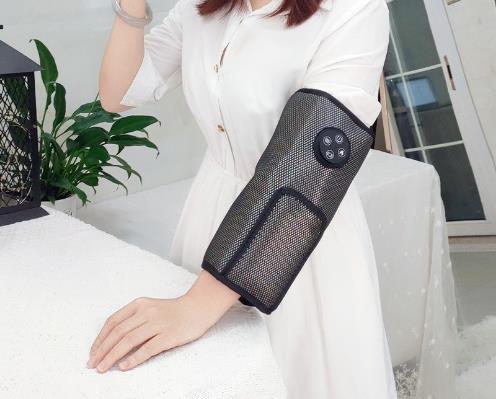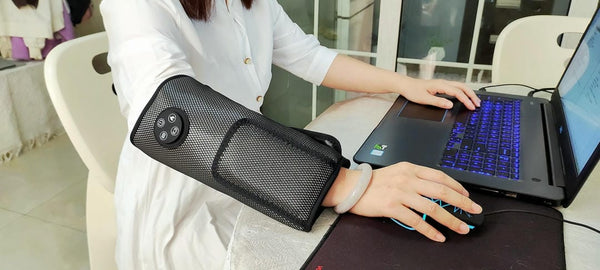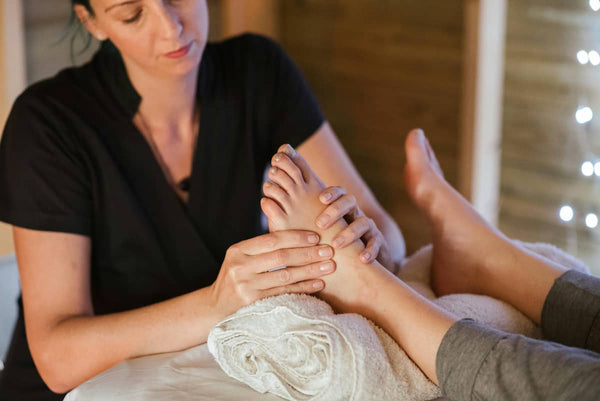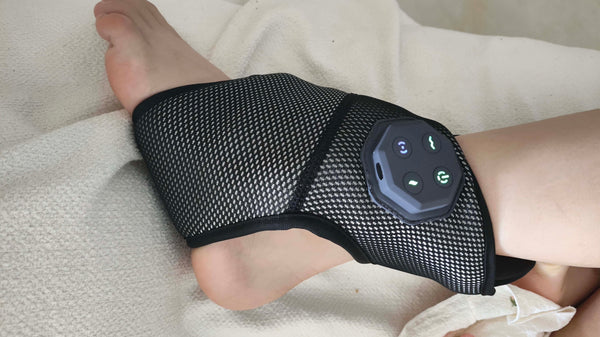 You know the feeling: you step off a long-haul flight, and your lower back feels like a solid plank of wood. Or perhaps it's the end of a glorious day of sightseeing, but your feet and lumbar region are screaming in protest. For travellers, these aches are often seen as an unavoidable price of admission. In response, a booming market of portable massage machines has emerged, promising on-the-go relief in a compact package.
You know the feeling: you step off a long-haul flight, and your lower back feels like a solid plank of wood. Or perhaps it's the end of a glorious day of sightseeing, but your feet and lumbar region are screaming in protest. For travellers, these aches are often seen as an unavoidable price of admission. In response, a booming market of portable massage machines has emerged, promising on-the-go relief in a compact package.
But amidst the marketing hype, a crucial question remains: are these gadgets truly effective, or are they just expensive toys that take up precious luggage space? As an evaluator of health products, my goal is to cut through the noise. We'll objectively analyze the science, weigh the real-world pros and cons, and provide a rational guide to help you decide if a massage meachine is a smart investment for your travels.
What Travel Really Does to Your Body
To evaluate the solution, we must first understand the problem. The physical toll of travel goes beyond simple fatigue. When you're crammed into an airplane or car seat for hours, your muscles are held in a static, shortened position. This reduces blood flow, leading to stiffness and that all-too-familiar achy feeling. The body's circulatory system, responsible for delivering oxygen and removing waste products like lactic acid, becomes sluggish in these compressed areas.
Then comes the activity. A day of walking on cobblestone streets or carrying luggage puts an unusual strain on your muscles and connective tissues, causing micro-tears and inflammation. The lower back, which supports the entire upper body, is particularly vulnerable to this kind of strain. It is this specific set of problems—poor circulation, muscle knots, and inflammation—that modern massage machines are engineered to tackle.
The Science: How a Machine Can Mimic a Massage
Let's be perfectly clear: no machine can fully replicate the intuitive, adaptive touch of a skilled human therapist. However, they can effectively mimic the core mechanical principles of massage to deliver tangible benefits. From an evaluative standpoint, their effectiveness hinges on a few key technologies.
- Vibration Massage: This technology uses high-frequency oscillations to create a soothing sensation that penetrates the muscles. Unlike aggressive deep-tissue percussion, vibration is generally gentler, making it excellent for relaxing tense back muscles, stimulating surface-level circulation, and calming the nervous system.
- Hot Compress (Thermotherapy): A classic and effective method. Applying heat helps to relax muscle fibers, making them more pliable and reducing stiffness. It also has an analgesic (pain-relieving) effect by stimulating sensory receptors in the skin, which can help block pain signals from reaching the brain. This is a key feature in a good professional body massager.
- Red Light Therapy (Photobiomodulation): An emerging technology now found in advanced massagers. It uses specific wavelengths of red light (typically 630-660nm) that penetrate the skin to stimulate the mitochondria within your cells. This is thought to boost cellular energy and may help reduce inflammation and promote tissue repair.
- Air Compression: This is a game-changer for travellers' legs and feet. Inflatable chambers systematically squeeze and release the limbs, creating a pumping action that assists lymphatic drainage and reduces the swelling and heaviness that often follows a long flight.
The Real-World Benefits for the Weary Traveller
 Based on extensive user feedback and performance tests, the benefits of using massage machines during travel are quite clear, provided expectations are realistic. The primary advantage is not a "cure" for chronic conditions but rather a powerful tool for on-demand symptom management and recovery. Skeptics are right that machines lack a therapist's dynamic adjustment, but their consistent application offers its own set of advantages.
Based on extensive user feedback and performance tests, the benefits of using massage machines during travel are quite clear, provided expectations are realistic. The primary advantage is not a "cure" for chronic conditions but rather a powerful tool for on-demand symptom management and recovery. Skeptics are right that machines lack a therapist's dynamic adjustment, but their consistent application offers its own set of advantages.
Here are the most commonly reported benefits:
- Immediate Post-Travel Relief: Targeting your lower back and hips with a portable massager after a flight can significantly ease stiffness and make your arrival more comfortable.
- Enhanced Daily Recovery: Using a device on your feet, calves, and especially your lower back in the evening can reduce soreness and help you feel more refreshed and ready for the next day's adventures.
- Cost and Convenience: For the frequent traveller, the one-time cost of a quality massager is far less than booking massages in different cities. The convenience of having it in your hotel room is unmatched.
- Management of Chronic Pain: Some users with recurring issues like lower back pain report that consistent, daily use of massage machines helps keep the pain at a manageable level, though effectiveness is highly individual.
The Evaluator's Guide to Choosing a Travel-Friendly Massager
Not all massage machines are created equal, especially when luggage space and weight are at a premium. A common pitfall is buying a bulky device that ends up being left at home. The key is to match the tool to your specific travel style and primary pain points, particularly that nagging lower back.
Consider these categories:
- Multifunctional Waist Massagers: These are the "Swiss Army knives" of portable relief. They combine several therapies into one compact, belt-style device, often featuring both air wave and vibration massage, along with added hot compress and red light therapy. This multi-pronged approach tackles lower back pain from all angles: vibration for soothing, air waves for gentle stretching, heat for relaxation, and red light for cellular support.
- Portable Shiatsu Cushions/Pads: A great option for passive relief. These are small cushions or flexible pads with rotating massage nodes that can be strapped to a hotel chair or used while lying in bed to target the lower back. Many also include a heat function, providing a comforting and consistent kneading massage to ease lumbar tension.
- Portable Leg Massagers (Air Compression): While focused on the legs, these are vital for overall travel comfort. By improving circulation in your lower limbs, they reduce swelling and fatigue, which can indirectly alleviate strain on your lower back. They are the ideal machine for joint-related aches in the legs by improving circulation around the area.
Best Practices: How to Use Your Device Safely and Effectively
Owning a powerful tool is only half the battle; knowing how to use it correctly is what prevents you from doing more harm than good. The goal is therapeutic relief, not a test of your pain tolerance. Rushing in with the highest intensity is a classic rookie mistake.
Follow these simple, rational guidelines:
- Start with a Moderate Setting: Begin with a moderate pressure and heat setting to allow your muscles to adjust. You can change the intensity as you see fit.
- Position for Comfort: Ensure a snug but comfortable fit. The device should make firm contact with your lower back muscles but should not be so tight that it restricts breathing or causes pain.
- Relax and Let it Work: For a sustained session, you can use the device on the general lower back area for about 5 to 15 minutes. This is ideal for a device featuring hot compress and sustained vibration or air pressure.
- Listen to Your Body: A "good" sensation is one of deep warmth and relieving pressure. If you feel any sharp, shooting, or electric pain, or if the pressure feels painfully excessive, stop immediately.
Final Verdict: A Worthy Travel Companion?
So, do massage machines work for travellers? The definitive answer is yes—with caveats. They are highly effective as tools for managing the acute, temporary symptoms of travel-related aches and stiffness, especially in the lower back. They can accelerate recovery, improve comfort, and offer unparalleled convenience.
However, it's crucial to acknowledge their limitations. They cannot diagnose an underlying injury, and they lack the precision to resolve complex, chronic issues that require the hands-on expertise of a physical therapist. Think of a portable multifunctional waist massager as your personal, on-call "first aid" for muscle fatigue, a role it performs exceptionally well. For the modern traveller, choosing a quality, portable device is a rational step toward making every journey a more comfortable one.
Frequently Asked Questions
What are the benefits of machine massage vs. human massage?
The primary benefit of massage machines is accessibility and cost. You have 24/7 access to relief for a one-time purchase. They are excellent for general soreness and regular maintenance. A human massage, by contrast, offers diagnosis and precision. A trained therapist can identify the root cause of your pain, adjust pressure in real-time based on your feedback, and perform complex techniques that machines cannot replicate. The machine is for convenient relief; the therapist is for corrective treatment.
How to assess the safety of a machine massage device?
Safety assessment involves a few key checks. First, stick to reputable brands with a history of positive customer reviews and transparent warranty/return policies. Second, look for safety certifications (like CE, ROHS, FCC) which indicate the device has passed standardized safety and material tests. Third, ensure the device has variable intensity settings—a single, high-power setting is a red flag. Finally, read the user manual carefully for specific contraindications related to health conditions.
Which machine massage options are best for joint pain?
This requires a critical distinction: you should never use a high-intensity massager directly on a joint (like a kneecap or elbow). This can cause inflammation and damage. The effective approach is to treat the muscles *surrounding* the joint. For this, a gentle machine for joint support is ideal. Low-intensity vibration or an air compression device can increase blood flow to the area, relaxing the tight muscles and tendons that pull on the joint, thereby reducing pain indirectly and safely.
This reply is generated based on currently verifiable public information. It is recommended to cross-check key content with authoritative sources.




0 comments